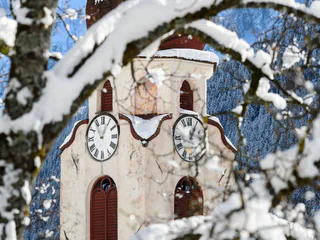
1/2
Welschnofen Parish Church
Nova Levante/Welschnofen, Welschnofen/Nova Levante, Dolomites Region Eggental
Sur les traces de notre histoire, tu te baladeras dans des châteaux et des forteresses, tu visiteras des églises et des monastères et tu découvriras, lors de visites guidées, des témoins de l'époque, des bâtiments et des places dignes d'intérêt. Inspirées par les anciens et les nouveaux maîtres, les coutumes et l'actualité, les différentes manifestations culturelles telles que les expositions, le théâtre, la danse et la musique t'invitent à échanger avec l'art et la culture.

1/2
Nova Levante/Welschnofen, Welschnofen/Nova Levante, Dolomites Region Eggental

1/2
S. Martino/St. Martin - S.Lorenzo/St. Lorenzen, St.Lorenzen/San Lorenzo di Sebato, Dolomites Region Kronplatz/Plan de Corones

S. Pietro/St. Peter - Funes/Villnöss, Villnöss/Funes, Dolomites Region Villnösstal

Sesto/Sexten, Sexten/Sesto, Dolomites Region 3 Zinnen

1/2
Colfosco/Colfosco, Corvara, Dolomites Region Alta Badia

1/3
Issengo/Issing, Pfalzen/Falzes, Dolomites Region Kronplatz/Plan de Corones

1/2
La Val/La Val, La Val, Dolomites Region Alta Badia

1/5
Brunico città/Bruneck Stadt, Bruneck/Brunico, Dolomites Region Kronplatz/Plan de Corones

1/2
Brunico città/Bruneck Stadt, Bruneck/Brunico, Dolomites Region Kronplatz/Plan de Corones

1/4
Sesto/Sexten, Sexten/Sesto, Dolomites Region 3 Zinnen

1/7
Villabassa/Niederdorf, Niederdorf/Villabassa, Dolomites Region 3 Zinnen

1/3
Fiè/Völs, Völs am Schlern/Fiè allo Sciliar, Dolomites Region Seiser Alm

1/2
La Villa/La Villa, Badia, Dolomites Region Alta Badia

Sesto/Sexten, Sexten/Sesto, Dolomites Region 3 Zinnen

Piccolino/Pikolein, San Martin /San Martino, Dolomites Region Kronplatz/Plan de Corones

1/2
Tiso/Teis, Villnöss/Funes, Dolomites Region Villnösstal

1/3
Castelrotto/Kastelruth, Kastelruth/Castelrotto, Dolomites Region Seiser Alm

Merano/Meran, Meran/Merano, Dolomites Region Val Gardena

1/5
Villabassa/Niederdorf, Niederdorf/Villabassa, Dolomites Region 3 Zinnen

1/3
Brunico città/Bruneck Stadt, Bruneck/Brunico, Dolomites Region Kronplatz/Plan de Corones

1/2
Pieve di Marebbe/Enneberg Pfarre, Al Plan/San Vigilio, Dolomites Region Kronplatz/Plan de Corones

1/5
Sureghes/Oltretorrente/Sureghes/Überwasser, Urtijëi/Ortisei, Dolomites Region Val Gardena

Issengo/Issing, Pfalzen/Falzes, Dolomites Region Kronplatz/Plan de Corones

1/7
Piccolino/Pikolein, San Martin /San Martino, Dolomites Region Kronplatz/Plan de Corones

1/3
Badia/Badia, Badia, Dolomites Region Alta Badia

Dobbiaco Nuova/Neutoblach, Toblach/Dobbiaco, Dolomites Region 3 Zinnen

1/3
Sesto/Sexten, Sexten/Sesto, Dolomites Region 3 Zinnen

Braies di Dentro/Innerprags, Prags/Braies, Dolomites Region 3 Zinnen

1/2
Sesto/Sexten, Sexten/Sesto, Dolomites Region 3 Zinnen

San Vigilio, Al Plan/San Vigilio, Dolomites Region Kronplatz/Plan de Corones